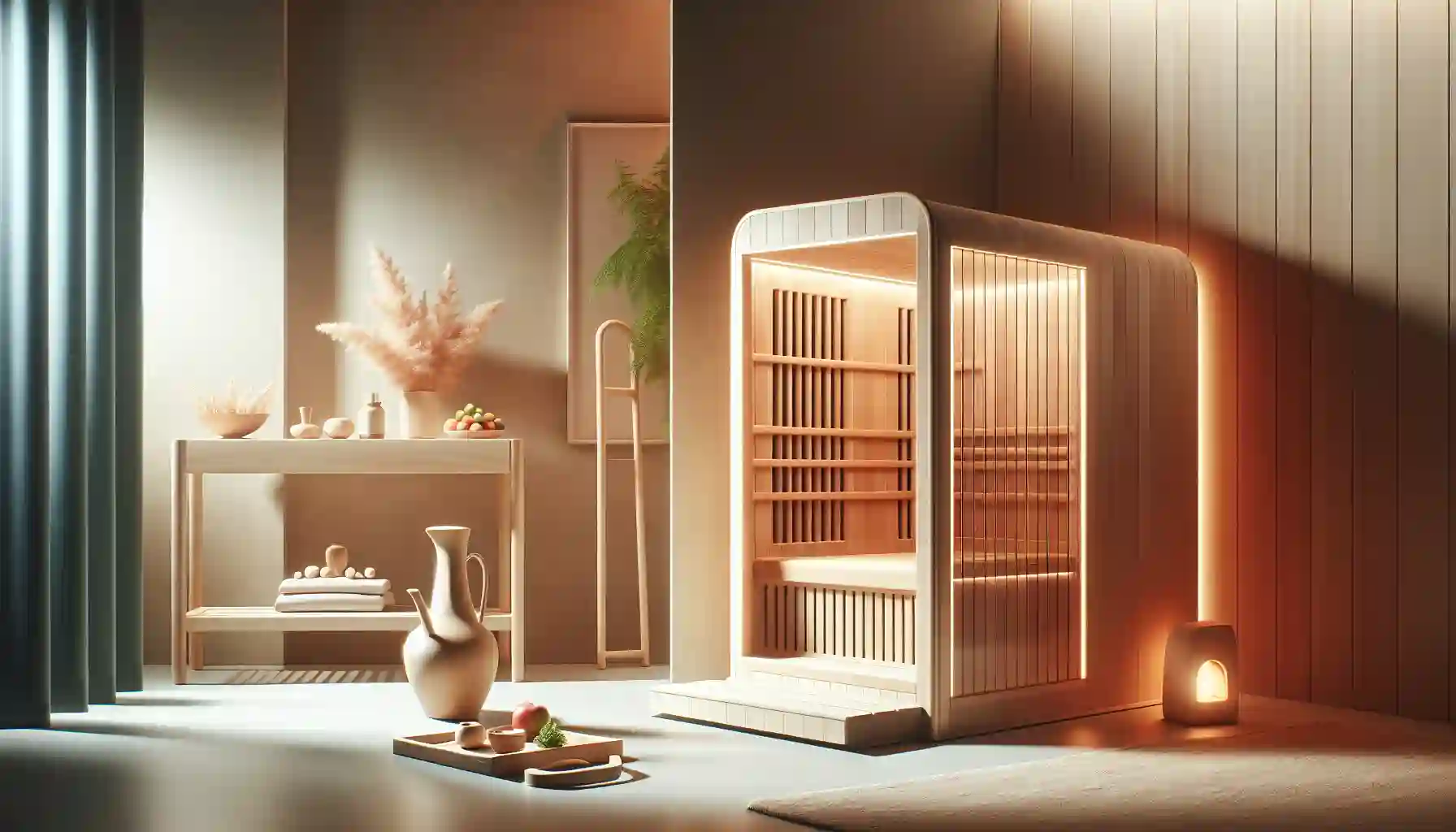infrared saunas work differently than the traditional saunas you might picture. Instead of heating the air around you to very high temperatures, they use infrared light to warm your body directly. This creates a deep, gentle heat that can feel more comfortable and allows for longer sessions at lower temperatures. It’s this unique mechanism that’s drawing interest for its potential wellness benefits, particularly for those managing chronic conditions like type 2 diabetes.
Let's explore how infrared sauna therapy might fit into a comprehensive diabetes management plan, what the science says, and how to approach it safely.
How Infrared Saunas Work
You might think all saunas are the same, but that's not quite right. A traditional Finnish-style sauna heats the air to temperatures between 160°F and 200°F. This intense heat warms you from the outside in. An infrared sauna, on the other hand, operates at a much cooler 110°F to 140°F.
It uses special lamps to emit infrared light, a type of radiant heat that penetrates your skin and tissues more deeply. This process raises your core body temperature directly, making you sweat profusely without needing overwhelmingly hot air. Many people find this experience more tolerable, allowing them to relax for longer periods.
This "perceived exertion" is a key factor. Your body works hard to cool itself down, increasing your heart rate and circulation, similar to the effects of a light to moderate cardio workout. This gentle, passive cardiovascular conditioning is one reason researchers are exploring infrared sauna benefits for metabolic health.
Potential Benefits for People with Diabetes
Managing diabetes is about more than just blood sugar. It involves protecting your heart, managing stress, and maintaining overall wellness. Here’s how regular infrared sauna use could potentially support several of these areas.
Insulin Sensitivity and Glucose Control
One of the most exciting areas of research is the link between heat therapy and insulin sensitivity. When your body is more sensitive to insulin, it can use glucose from your bloodstream more effectively, which helps keep blood sugar levels stable. Some small studies suggest that regular sauna use may improve insulin sensitivity. The proposed mechanism is linked to increased production of "heat shock proteins," which can reduce inflammation and improve cellular glucose uptake.
While more robust human trials are needed, the idea that passive heating could support better blood sugar management is promising.
Cardiovascular Health and Circulation
People with diabetes have a higher risk of cardiovascular disease. Improving circulation and heart health is a top priority. Infrared saunas cause your blood vessels to dilate (widen), which can improve blood flow throughout the body.
This process, known as vasodilation, may help lower blood pressure and reduce stiffness in the arteries. A study published in a reputable medical journal noted that repeated sauna therapy improved vascular function in patients. For individuals with diabetes, better circulation is crucial, as it delivers oxygen and nutrients to tissues, especially in the extremities like the feet, which are often affected by diabetic neuropathy.
Stress Reduction and Sleep Quality
Stress is a major enemy of blood sugar control. When you're stressed, your body releases cortisol, a hormone that can raise blood glucose levels. Finding ways to relax is essential.
The gentle, enveloping warmth of an infrared sauna provides a perfect environment for deep relaxation. It helps calm your autonomic nervous system, shifting it from a "fight-or-flight" state to a "rest-and-digest" mode. This reduction in cortisol can have a direct, positive impact on your blood sugar. Many users also report significantly better sleep after sauna sessions, and quality sleep is a cornerstone of good metabolic health.
Muscle Recovery, Neuropathy Comfort, and Joint Stiffness
From post-exercise soreness to the chronic aches of diabetic neuropathy, physical discomfort can be a daily struggle. The deep-penetrating heat from an infrared sauna can help:
Soothe sore muscles: By increasing blood flow, it helps clear out metabolic waste products and delivers oxygen-rich blood to tired muscles.
Ease joint stiffness: The warmth can make connective tissues more flexible, providing relief for stiff joints.
Provide neuropathy comfort: While it won't cure nerve damage, many people find the gentle heat offers temporary relief from the tingling and pain associated with peripheral neuropathy.
What the Research Says
It's important to have a balanced perspective. Most of the research on infrared saunas and diabetes is still in its early stages. Many studies are small, observational, or have been conducted on specific populations. While the results are encouraging, we are still waiting for large-scale, randomized controlled trials (RCTs)—the gold standard of medical research—to draw firm conclusions.
A review of existing evidence on passive heat therapy, including saunas, highlights potential benefits for cardiometabolic health markers. You can explore some of this research on platforms like PubMed. However, it's critical to understand that infrared sauna therapy is a complementary practice, not a standalone treatment. It should be used to support—not replace—the medical advice, medications, and lifestyle changes prescribed by your healthcare team.
Safety First: Who Should Avoid or Get Medical Clearance
An infrared sauna is not safe for everyone. If you have any of the following conditions, you must speak with your doctor before trying sauna therapy.
Uncontrolled high blood pressure: The heat-induced changes in heart rate and blood pressure could be dangerous.
Severe peripheral neuropathy: If you have lost sensation in your feet or hands, you might not feel if the heat is too intense, leading to burns.
Autonomic neuropathy: This condition affects your body's ability to regulate heart rate, blood pressure, and body temperature, making sauna use risky.
Advanced kidney disease: Sweating heavily can cause dehydration and strain on the kidneys.
Pregnancy: It is generally recommended to avoid saunas during pregnancy.
Open wounds or infections: Heat can worsen inflammation and infection.
Recent alcohol consumption: Alcohol dehydrates you and impairs judgment, a dangerous combination with heat therapy.
Certain medications: Some drugs can be affected by heat or cause dehydration. Always check with your doctor or pharmacist.
The National Institute of Diabetes and Digestive and Kidney Diseases (NIDDK) is a great resource for general diabetes safety information.
How to Use an Infrared Sauna for Blood Sugar Support
If you and your doctor agree that infrared sauna use is safe for you, a thoughtful approach is key to maximizing benefits and minimizing risks.
Setup and Timing
Consider using the sauna on your rest days from exercise or after a light workout. Some people find a post-meal session helpful, but you should monitor your own blood sugar to see how your body responds. Avoid using the sauna if you feel unwell or your blood sugar is unstable.
Temperature and Duration
Start slow. A good starting point is a lower temperature for a shorter duration.
Beginner: Set the sauna to 110–120°F and stay in for 10–15 minutes.
Progression: As you get comfortable, you can gradually increase the temperature to 130–140°F and extend your sessions to 20–30 minutes. Listen to your body—more is not always better.
Hydration and Electrolytes
This is non-negotiable. You will sweat a lot, losing both water and essential minerals called electrolytes.
Before: Drink 16–20 ounces of water in the hour leading up to your session.
During: Keep a water bottle with you and sip if you feel thirsty.
After: Rehydrate with another 16–20 ounces of water. Add a pinch of sea salt or an electrolyte powder to help replenish lost minerals like sodium, potassium, and magnesium. The CDC offers great information on hydration for health.
Monitoring Glucose and Symptoms
Pay close attention to how your body reacts. If you use a continuous glucose monitor (CGM), watch for trends on sauna days. If you use fingersticks, consider testing your blood sugar before and about an hour after your session to see the effect. Keep a log of your sauna duration, temperature, and your glucose readings to identify patterns.
Build a Simple Weekly Routine
Consistency is more important than intensity. A gradual ramp-up allows your body to adapt.
Week 1: Two sessions of 15 minutes each at 115°F.
Week 2: Three sessions of 15–20 minutes each at 120°F.
Week 3: Three sessions of 20 minutes each at 125°F.
Steady Routine: Aim for a sustainable schedule of 3–4 sessions per week, lasting 20–30 minutes each, at a temperature that feels comfortable yet makes you sweat.
Pair Sauna Time with Habits that Help Glucose
You can "stack" healthy habits with your sauna time to amplify the benefits.
Mindful Breathing: Use your time in the sauna to practice deep, slow breathing to further reduce cortisol.
Gentle Stretching: After your session, when your muscles are warm, do some light stretching to improve flexibility.
Smart Hydration: Choose water or a low-sugar electrolyte drink over sugary sports drinks.
Post-Sauna Snack: If you're hungry afterward, have a small snack with protein and healthy fat to help stabilize blood sugar.
When to Stop and Seek Help
Always prioritize safety. Exit the sauna immediately if you experience any of these red flags:
Dizziness, lightheadedness, or headache
Nausea
Rapid or irregular heartbeat
Chest pain
Sudden changes in vision
If symptoms persist after you've cooled down and rehydrated, or if you notice consistent and concerning changes in your blood sugar patterns on sauna days, consult your doctor.
A Supportive Tool, Not a Replacement
Infrared sauna therapy can be an empowering and pleasant addition to a diabetes wellness toolkit. The potential to improve circulation, reduce stress, and possibly support insulin sensitivity makes it an attractive option for proactive symptom management.
However, it's crucial to approach it with a clear-eyed view. An infrared sauna is a supportive tool, not a cure or a substitute for the foundations of diabetes care: medical supervision, a healthy diet, regular exercise, and prescribed medications. When used wisely and safely, it can be another way you actively care for your body and invest in your long-term health.



